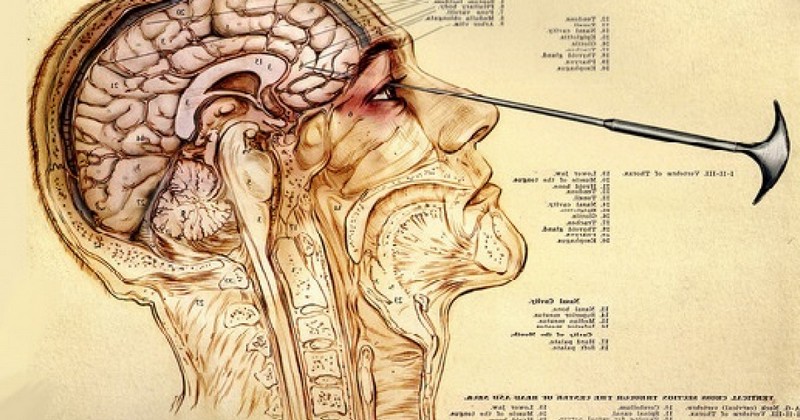What is a lobotomy and for what purpose was it performed?

A summary of this brutal brain surgery practice.
In the year 1935, the Portuguese neurosurgeon and psychiatrist António Egas Moniz performed a surgical intervention he called leucotomy.
It consisted of making two holes in the front of the skull, and injecting alcohol directly into the frontal lobe of the brain through them. Years later, this practice had come to be called lobotomy.and its popularity in the world of psychiatry led Egas Moniz to win the Nobel Prize for Medicine in 1949. What had happened?
The birth of lobotomy
The etymology of the term leukotomy serves to give us an idea of the purpose of lobotomies; leuko means target, and take means cut. Egas Moniz believed that certain mental disorders could be cured by breaking some areas of the brain in which the frontal lobe communicates with other areas of the brain. That is, by damaging parts of the white matter of the brain, so called because it is dominated by axons (the parts of the neuron that elongate to communicate with distant nerve cells).
This neurosurgeon started from the idea that it was possible to considerably reduce the intensity and frequency of the symptoms of psychiatric disorders by making all their psychological functions in general decline. A part of the intellectual capacity and personality of each patient was sacrificed in an attempt to bring him or her to try to bring him closer to a cure.
Walter Freeman's lobotomy
Egas Moniz's proposal may seem brutal today, but in its historical context it was well received in the field of non-Freudian psychiatry. In fact, in 1936, neurosurgeon Walter Freeman imported this type of intervention to the United States and, after giving it the name of lobotomy and, after giving it the name of lobotomy, made it popular all over the world.
Freeman also introduced some changes in the procedure. After stunning the patients with electroshock, instead of drilling two points in the skull and inserting spikes through them, he used ice pick-like instruments that he inserted through the eye socket, between the eye and the part of the bone above the eyebrow, and removed trying to "sweep" parts of the frontal lobes of each cerebral hemisphere.
As the wounds did not reach the deepest part of the brain, vital structures were not damaged and, in some cases, patients hardly noticed any changes during the first hours. In any case, the nervous system of these people was marked forever, and so was their way of behaving and experiencing life.
Why did lobotomy become popular?
It is hard to believe that the practice of lobotomies enjoyed a good reputation for a period of time, but it did.
After his method became known, Freeman went on to perform more than 2,000 lobotomies over the course of his career.. The practice of lobotomy spread rapidly throughout the West, and came to be considered one of the most useful tools available to medicine.
People who underwent lobotomy voluntarily or involuntarily were not only patients with serious mental disorders such as schizophrenia or severe depression; on many occasions this operation was used to solve cases of behavioral problems, disobedient adolescents, etc. Freeman's method may have been brutal, but a good portion of society was willing to embrace that brutality.
The idea of ending behavioral problems deeply rooted in the way of being with a few sessions was very tempting. Moreover, if the lobotomized persons were "calmer", it was possible to put an end to conflicts and relational problems by simply putting the focus on an individual who had to "change".
The logic behind this welcome by most of the health institutions had to do with the hygienist mentality they held. At that time people with psychiatric disorders were crammed into overcrowded hospitalsThey were often subjected to physical or psychological violence.
Lobotomy provided an opportunity to make such problems less obvious, easier to ignore. The patients were still sick, but after the operation it was less noticeable that they were there. The problem was solved in fiction and, in any case, the alternative to this practice was also terrible.
The emergence of psychotropic drugs and the end of the ice pick
The popularity of lobotomies began to plummet not because of a spontaneous awareness on the part of the population, but because of a rather less romantic event: the appearance of the first generations of psychotropic drugs for serious mental disorders in the mid-1950s.
Lobotomy promised an apparent quick solution to behavioral problems in just a few sessions, a commercial exchange that, considering the many problems it could solve (in the family, at work, etc.), paid off. However, psychotropic drugs were not only much more effective, they were also much cheaper.The risks of lobotomy were not only high, but also much simpler to apply.
Similarly, when one of Freeman's patients died from a hemorrhage caused by the neurosurgeon, it became clear that the risks of lobotomy were high. In the 1950s and 1960s, many countries banned this kind of intervention, and the USSR even banned it.and the USSR even considered it "contrary to human rights".
Nevertheless, lobotomy had enjoyed such a good image that it still took a couple of decades to appear. The simplicity of the procedure (which could be performed in less than 10 minutes) still made this measure an attractive option for when there was no supervision by relatives or public entities.
Bibliographic references:
- Cosgrove, G. Rees; Rauch, Scott L. (1995). "Psychosurgery" Neurosurg. Clin. N. Am.
- Martínez, Luis Antonio (2009). Reconstructive regressive therapy. Libros en Red.
(Updated at Apr 14 / 2024)